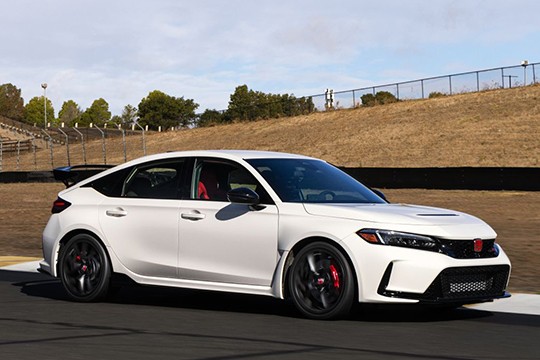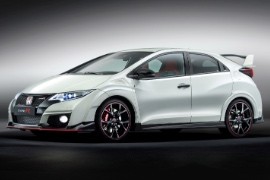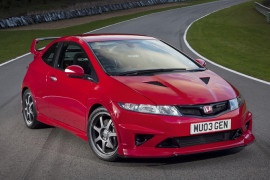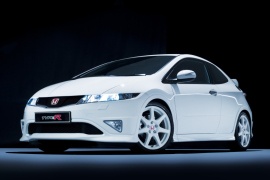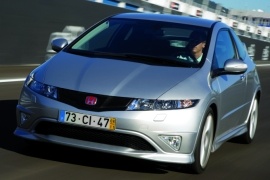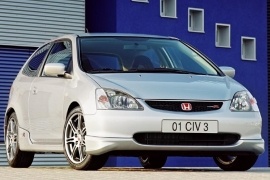HONDA Civic Type-R Models/Series Timeline, Specifications & Photos
First production year: 2001
Engines: Gasoline
Body style: Hatchback
Honda introduced the sixth generation of its Civic Type R in July 2022 for the 2023 model year and heated up the hot-hatch segment once again.
With over 25 years of history, the Type R moniker always spelled an aura of a performance car dressed in civilian clothes. It was the car that could do a school run, a shopping day, and a day at the track without tearing a sweat. But, with the introduction of the sixth generation of this nameplate, installed on the eleventh generation of the Civic, the Japanese automaker finally combined the turbocharged engine with the independent suspension in all corners.
While its predecessor looked outrageous, with manga-inspired styling, and a huge wing on the back, the 2023 Type R looked less aggressive. Its front fascia showed the specific red H badge on the black grille, while the lower bumper received real side air-intakes that improved the car's aerodynamics. In addition, the automaker installed a functional scoop on the hood meant to draw cold air into the engine bay. Finally, at the back, Honda offered a big wing fitted as an option. It wasn't standard anymore and thus not present on any Type R.
Unlike its regular Civic sibling, the Type R featured sport bucket seats with cut-outs for racing harnesses into the tall seatback. In front of the driver, the carmaker installed a TFT screen, while atop the center stack, Honda placed a digital display. Unlike the regular Civic, the Type R received a gear stick on the center console.
Underneath the hood, Honda installed a reworked version of the same K20C1 inline-four powerplant featured on the fifth generation. Yet, the 2023 model year provided more power than its predecessor offered. Finally, like any other Civic Type R, this version was exclusively available with a six-speed manual.
When Honda introduced the 2017 Civic Type-R on the market, it ended a 16-year hiatus of rear independent suspension and regained the hot-hatch segment's crown.
While other carmakers adopted turbocharged engines to boost the power of their powerplants, Honda squeezed more ponies from naturally aspirated ones. But in the end, it had to adopt the turbocharged technology for its hot-hatch. So it installed them on the tenth generation of the Civic and carried over the powerplant from the ninth Civic Type-R.
From the outside, the Type-R looked like a madman tuned it. It featured a massive wing on the back and a dazzling look. Even though not all the grilles on the front and rear bumpers were not functional, they looked mean and added an aggressive look for the Japanese hot-hatch. On the hood, the carmaker added a functional scoop that fed air to the intercooler. Another unique feature of the Type-R was the three pipes in the back. The outer ones were exhausts, while the middle was for an intake and changed the engine sound.
The interior was reworked when compared with the rest of its Civic siblings. It featured wide, sport-bucket Recaro seats upholstered in red suede, which sported the Type-R badges embroidered on their seatbacks. The dashboard looked similar to the other Civics, but it gained a Type-R logo and a new, red background color. Thanks to its unique steering wheel and metallic pedals, the carmaker created a sporty, racy vehicle for petrolheads.
Thanks to the all-wheel independent suspension and adaptive dampers, the Type-R regained its status among the hot-hatches. Moreover, unlike other competitors, Honda installed a six-speed manual only for the vehicle and added a standard limited-slip differential. As a result, the car managed to score record lap-times on various race tracks worldwide, including on the famous Nurburgring.
After five long years of waiting, Honda fans from Europe were pleased with the fourth generation of Civic TypeR. It is the first generation of the Japanese hot-hatch that received a turbocharger for its 2.0-liter gasoline engine. It is unusual for the master of natural aspirated engines to introduce a turbocharger for the sporty hot-hatch, but it was the only way to keep-up with other European manufacturers such as Ford, Volkswagen or Renault.
From the outside, the lines are dramatically enhanced compared with the regular Civic. A bigger rear wing, bigger wheel-arches and 19” light-alloy wheels are completing the image of a road-warrior compact car. The manufacturer claimed that the exaggerated aerodynamics have been studied so the vehicle will have a negative lift factor, which is unusual for its class.
Inside, the new Recaro front bucket-seats are upholstered in Alcantara and will assure a proper support for the occupants. The rear bench-seat is kind of dull, looking like it will spend its whole life on the garage's floor. It is flat and without any side support. But it still has Alcantara trim.
The main components of the Civic TypeR are under the hood. The engine offers 310 hp and 400 Nm (295 lb-ft) of torque between 2500 to 4500 rpm. The 6-speed manual gearbox was calibrated for maximum performance so the top speed of 270 kph (168 mph) will be achieved in 6th gear at 6500 rpm. The 0-100 kph (0-62 mph) sprint is obtained in just 5.7 seconds.
Mugen's work was already known among Honda's fans, who begged the carmaker to create a special version for the European Civic Type-R. And that came in 2009.
Limited to just 20 units for UK enthusiasts, the reworked Mugen Type R was mostly a street version of an FIA Group N racing car. As expected, the works on the vehicle were not limited to just an aesthetic package. Still, they included the whole vehicle, from top to bottom.
The tuner took a standard three-door Civic Type-R and stripped it from bumpers, side sills, and the rear spoiler. Thus, the front of the car looked much more aggressive, with the triangular foglights replaced by round air intakes that flanked the broad lower front grille. Moreover, the upper grille was replaced by a Mugen-badged one, while the hood received two vents that extracted the hot air from the engine compartment. In addition, the side sills were reworked with additional sculptured areas. At the same time, at the back, the bumper sported two wide, round exhausts flanking the diffuser. Last but not least, Mugen added an oversized wing mounted on the liftgate.
Inside, the tuner made some changes to the dashboard and added, as an option, three more gauges above the lower instrument cluster. The Civic VIII had two instrument panels, one lower where the tachometer took center stage and an upper one for various info from the onboard computer, speed, and shift lights.
But the main changes were under the hood, where the famous, naturally-aspirated K20 engine was bored, and its displacement was increased by about ten percent, up to 2.2-liter. Then, thanks to other modifications and a new ECU, the power jumped from 201 PS on a regular Type-R to an astonishing 260 PS (from 198 HP to 256 HP).
When it prepared for the stricter Euro5 emission standards, Honda also added a slight refresh to the Civic lineup, and that also included the Type R hot-hatch.
From its first generation, the Type R was built by enthusiasts for enthusiasts. That was easy to see in every detail of the car. Unlike the Golf GTI, which was made as a civilized daily driver, the Type R was built with many compromises in the comfort sector and just a few in the performance area.
While the rest of the range received a few styling upgrades, the Type R's design was virtually left untouched. It still featured the black mesh grille a the front like its predecessor and, depending on the trim level, a set of triangular foglights in the apron, flanking a second grille to cool the engine and the AC condenser. Also, Honda decided to keep the same three-door bodywork. At the back, the Type R featured a different, wider, mid-mounted wing on the tailgate.
Honda offered the Type R (FN2) in a few trim levels, starting with the GT stripped by the AC unit, the stereo, and the foglights, and ended up with the Heritage and Navi. The latter offered a navigation system with the screen installed into the dashboard. The high-mounted seats annoyed customers, but there was nothing that they could do about that since the fuel tank was located under the driver's seat.
Unlike the previous Type R, the EP3, the FN2 featured a semi-independent suspension, which altered the car's behavior on the street. However, it was marginally better on a race track. Under the hood, Honda installed a slightly upgraded version of the K20 engine mated to a sleek six-speed manual.
The eighth generation of the Civic hatchback received a Type R version in 2006, and it wasn't exactly what the brand's fan waited.
Honda Civic Type R always was a car designed for enthusiasts, by enthusiasts. Still, the European version of the Type R, the FN2, was available only as a three-door hatchback with the same torsion-beam in the back. While that was useful to increase the trunk space for a family vehicle, it was worse than the independent-type suspension installed on its predecessor, the EP3.
It was a car like no other on the market. Its sharp front end with the narrow grille and slim headlights were features that couldn't be found elsewhere on the car market. Unlike its regular siblings, the Type R featured a mesh-grille instead of the glass-covered area between the headlights. Its profile was similar to the three-door version, the Type S, but the rear spoiler was specific for the Type R.
The carmaker installed red and black sport bucket seats at the front, with high bolstering to hold the occupants in place during hard cornering. It featured a specific instrument cluster with red background lights instead of the blue ones on the rest of the range. A hidden menu could reveal the shift-lights installed on top of the speedometer, which was in a separate, upper cluster. Yes, the rear seats were folding and could increase the luggage area, but there were just a few who bought a Type R for its trunk space.
Under the hood, Honda installed an 8.000 rpm screaming engine, which provided an extra horsepower (1 hp) than its predecessor. At least it was a Euro 5 compliant engine. As usual, the Type R was available exclusively with a manual gearbox.
The Type R was the sportiest version of the well-known Honda Civic. Its 8000 rpm screaming engine transformed the 3-door hatchback into an intoxicating hot-hatch.
The seventh generation of the Honda Civic was available in a few body versions, including a coupe, a sedan, a 5-door hatchback, and the 3-door version. The latter was offered as a TypeR as well. It was the first Civic TypeR built in the U.K. and the first to be offered on European soil.
Over time, it gained a lot of nicknames, from the "bread-van" to "screaming box on wheels," but its look was simple and designed with the "form follow function" concept. A pair of triangular-shaped headlights, with corner-mounted white turn-signals, and a smiling radiator grille didn't give a clue about what the car could do. The lower grille in the front helped to cool the engine.
Inside, Honda installed red&black sport-bucket Recaro seats with integrated headrests. The rear bench was black with a split-folding seatback to expand the small trunk. Like the 5-door version, the Type R featured an in-dash gear-stick that popped-out through the center stack. Honda installed it there to be closer to the steering wheel and easier to shift gears. The stereo-CD was fitted as standard. Later on, Honda offered a sat-nav system on the options list in selected countries.
The TypeR magic happened under the hood, where the 2.0-liter naturally aspirated engine provided 200 hp. The four-pot featured the VTEC (Variable Valve Timing & Lift Electronic Control) system that allowed the car to go over the magical 100 hp/liter barrier. It was paired to a 6-speed manual and sent the power to the front wheels via a helical LSD. It's stiffer, fully independent suspension and weight balance made it a fast-cornering car.
